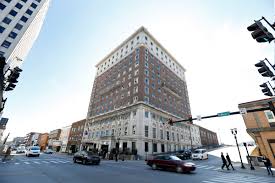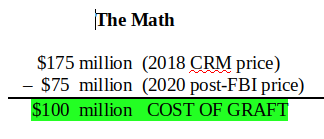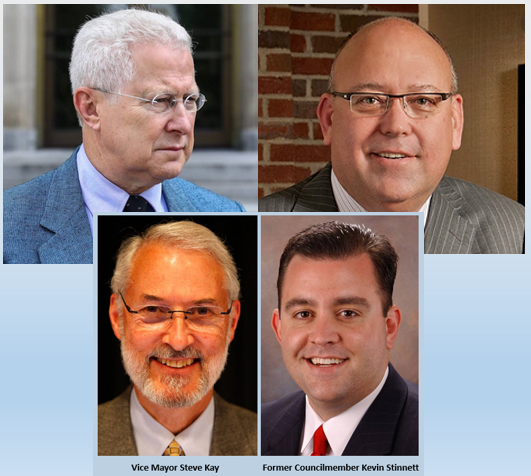There were two developments last week in the case of the United States of America v. Timothy Wayne Wellman, the local corruption trial that North of Center first reported on in December.
Wellman was an employee of CRM, a development company owned by Lexington Center Board Chairman Craig Turner. FBI lawyers assert that in Spring 2018, Wellman paid up to twelve individuals a total of $12,000 to make ghost donations to the political campaigns of Lexington Vice Mayor Steve Kay and then-Council Member at Large Kevin Stinnett (who at the time was running for Mayor).
Wellman did this, the case alleges, to help secure what would turn out to be a never-built $175 million contract for CRM to renovate the vacant Herald Leader building, which sits at the corner of Main Street and Midland Avenue, into a world class City Hall.
The most publicized development of the week was the long-delayed trial’s opening last Wednesday in Frankfort’s U.S. District Court. After five days of testimony, the jury took all of two hours this past Tuesday evening to declare Wellman guilty on all 11 counts of election fraud. (Technically, Wellman was convicted of 11 counts of obstruction of justice in the inquiry into his alleged election fraud. The actual election fraud case sits in the hands of the Kentucky Attorney General’s office. NoC will have more coverage of the federal trial at a later date.)
The second, less noticed, development in the CRM affair occurred a day after the Wellman trial began, as Lexington City Council again took up the decades old question, What in the Fayette Urban County ought we do with our City Hall? If the FBI trial offered an affirmative answer as to Wellman’s guilt in attempting to fix the 2018 answer to that question, last week’s council discussions began to flesh out the tangible costs to the public–dollars and cents–associated with his attempted fix.
In Spring 2018, when Wellman was alleged to have coerced low-level CRM employees to donate thousands of dollars to the campaigns of Vice Mayor Kay and At-Large Council Member Stinnett, then-Mayor Jim Gray (now Kentucky State Transportation Secretary) formed a secretive three person committee to secretly score four developer submissions for a new City Hall.

As it turns out, CRM’s $175 million proposal (a 35-year rent-to-own deal!) was chosen by this secret committee, in part based on what LFUCG Commissioner of Finance Bill OMara described as the proposal’s low “per square foot cost.”
Ultimately, as we now know, that 2018 CRM proposal was scuttled at the very last minute under a cross fire of corruption allegations: as Herald Leader coverage of the Wellman trial confirmed last Wednesday, the arrival of FBI agents to the scene discouraged council members (Kay in particular) from conducting their final, binding, vote.
But still, the amount–$175 million, paid out in annual $5.1 million General Fund installments to CRM over a 35 year period, at which point the city could assume ownership of its City Hall—sticks in the public record. We can track its progress. It was the end product of two years of studies, RFPs, secret-committee scores, and council-debates. The plan was championed in local media, most especially in the Lexington Herald Leader. To the degree the $175 million plan had public detractors, these were mostly advocates of a different, equally or more pricey, City Hall build. Were it not for those few late-arriving FBI agents, the damn thing would have become a living city contract that the city would be paying on today.
Fast forward two years, and last week’s great Council deliberations on the persistent City Hall question focused on two city-owned sites, neither of which featured in the four 2018 developer proposals. The first, a new build a hundred feet from the current City Hall at Phoenix Park, has less political support. The second, a renovation of the current Main and Vine Street location, holds both political and civil servant support. (The proposals appear to have been created by an in-house team of employees in the city’s facilities department.)

Both proposals, notably, project to cost between $70 and $80 million dollars.
This means that, whichever location council decides upon this year, we can now attach a figure to how much the CRM affair may have cost city residents: it was a $100 million graft.

With the conviction of Wellman in federal court, it would be easy to lay things to rest, to move on and look forward. This seems to be the case with the city’s paper of record, the Lexington Herald Leader, which even during its coverage of the city’s new, lower cost, options for City Hall, has neglected to mention the Wellman case. Here’s how our paper of record–the same journalist, in fact, who was covering the Wellman trial–chose to inform area readers about Council’s recent history in choosing a courthouse:
A new city government center has been on the city’s to-do list for decades. The city came close in 2018 when it selected CRM Companies of Lexington to renovate and retrofit the Lexington Herald-Leader building on Midland Avenue, but the council backed out of the private-public partnership at the last minute.
Lexington herald leader journalist Beth Musgrave
But the thing about grafts is that they are rarely individual acts. It takes a lot of hands to pull off a $100 million heist, and these many hands contribute to what we might call ‘heist inflation.’
Wellman was mainly the bag man, but there’s also the big boss man cut and the company cut. There’s the EOP architect cut. There’s the cut of political capital and donor support that accrue to CMs and Mayors who can make world-class projects happen. There’s the slowly-bankrupting paper of record cut–an off-loading of the vacant urban property it hasn’t been able to sell for nearly a half-decade. There are the cuts for the report consultants, the bank financiers, the secretly powerful secret committee members,and the adjacent TIF-recipient developers who could expect a couple hundred civil servant customers (maybe even the Mayor!) venturing out for lunch from their fancy new digs.
You’re not supposed to know it, but in 2018 the city dodged a hell of a fiscal bullet in not listening to the experts and civil servants, in not committing to an overcharge of $100 million from our already strained budget.
Developing as it did as a sort of capstone to the Jim Gray era, the CRM affair makes one wonder, what graft got passed through over the past decade of world class live/work/play policy, what celebrated projects were not sniffed out by FBI agents rushing to the scene?
Coda: on public leadership
Two years ago, when Timothy Wayne Wellman was out pushing straw contributions to our council members, the idea of renovating the current City Hall location was dismissed outright by all council members and then-Mayor Jim Gray as a drab, inelegant and impractical solution: a non-starter. Local media seem to have dismissed the idea for similar reasons. The progressive oracle Tom Eblen declared it “not well suited for a government center.”
At the time of the graft, 2018, only political outsiders like Don Pratt and long-shot council candidate Connie Kell conjoined their opposition to the $175 million CRM proposal with support for renovating the current City Hall location.
For her on-point leadership stand, Kell received under $500 in donations from her community and was not endorsed by the Herald Leader…nor by anyone else. She finished sixth in the six-candidate race.
Pratt didn’t run in 2018, but he experienced similar lackluster community and media support during his 2010 and 2014 council runs. Like Kell, he, too, was never endorsed by the Herald Leader, nor given coverage for his views.
Lexington: you are what your record says you are.





Don+Pratt
Why wasn’t Craig Turner not charged?